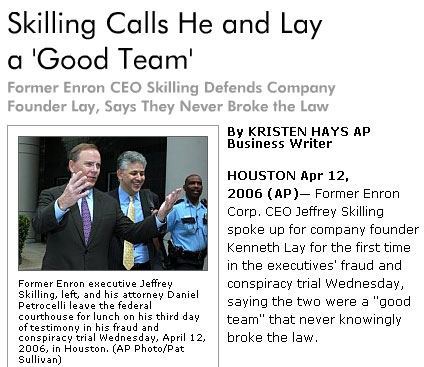April 12, 2006
Pronominal perplexity at the AP
Looks like the Associated Press today had a little bit of what Daffy Duck memorably called "pronoun trouble."
That's how the headline appeared on the ABC News website, and several other news sites that reproduced the AP story, such as Yahoo! News, Forbes, and Business Week, went with the exact same wording. Other versions of the AP headline must have gone out over the wire, as a Google News search turns up less vexatious variations, including: "Skilling says he, Lay never broke the law," "Skilling testifies that he and Lay never broke the law," and the pronoun-free "Skilling defends Lay At Enron trial."
In standard journalistic usage, we wouldn't expect the nominative pronoun he to show up in the headline, since the coordinate NP he and Lay appears as a direct object complement of the verb call. Like other members of what Beth Levin dubs the class of "dub verbs" (anoint, baptize, brand, etc.), call here takes two verbal complements: he and Lay (those who are called something) and a good team (what they are called). If a personal pronoun with a nominative-accusative distinction (I/me, we/us, he/him, she/her, they/them) shows up in the first complement of this sort of "double object" construction, norms of standard English dictate the accusative form (He branded me a liar, They named her CEO).
Things get a
little tricky, though, when the pronoun has a subject antecedent and is
coordinated with another NP (in this case Lay). If the headline writer opted
for the accusative case, there are four possibilities, depending on the
order of the coordinates and whether a reflexive pronoun is used:
(a) Skillingi calls himi and Lay a good team.
(b) Skillingi calls Lay and himi a good team.
(c) Skillingi calls himselfi and Lay a good team.
(d) Skillingi calls Lay and himselfi a good team.
Of these, (d) is likely the most acceptable in terms of standard usage, though it lacks the punchiness associated with headlinese. None of the selections sound particularly euphonious, which may have contributed to the AP writer's non-standard choice of the nominative case in the coordinate object he and Lay. Another possible contributing factor is suggested by Arnold Zwicky's post here last year, "Case nuances." Arnold notes that certain non-standard uses of nominative pronouns in coordinate objects are more acceptable than others. For instance, many people find sentences of type (e) moderately acceptable but reject (f) out of hand:
(e) Rachel wants you and I to...
(f) Rachel likes you and I.
In the above examples, Arnold writes, "the effect seems to have something to do with the fact that the coordinate NP is interpreted as the subject of the VP that follows it." Though there's no VP following he and Lay in the Associated Press headline, there is another complement, a good team. So it's possible that the two complements for call are treated together as a "small clause," encouraging a reading where the first complement is interpreted as the subject of the second, thus taking the nominative case.
I would also guess that the AP headline is the result of some rushed editing. The headline could have initially read, "Skilling says/claims/testifies (that) he and Lay were a 'good team,'" where he and Lay serves as the subject of a relative clause. Then an editor could have replaced "says (that)..." with "calls..." without changing the coordinate NP. But it's still telling that the headline was able to go out on the wires that way and was then deemed acceptable by editors at ABC News, Business Week, and elsewhere. The copy editors have unwittingly performed their own mini-experiment on the acceptability of a type of non-standard (soon to be standard?) pronominal usage.
Posted by Benjamin Zimmer at April 12, 2006 08:13 PM